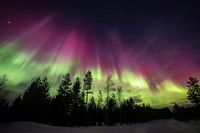Aurora is a natural light display in the sky, typically seen in the high latitude (Arctic and Antarctic) regions. Auroras are produced when charged particles from the sun interact with the upper atmosphere. The charged particles are funneled towards the Earth’s poles by our planet’s magnetic field.
When these charged particles collide with atoms and molecules in the upper atmosphere, they release energy in the form of photons. These photons then escape into space, giving rise to the characteristic colors of an aurora – green, red, blue, and violet.
Auroras typically occur at altitudes between 80-160 km (50-100 miles). They can be extremely bright – often outshining even the stars and moon – or very faint, depending on solar activity. Solar activity is greatest during what is known as “solar maximum.” This occurs approximately every 11 years; currently we are nearing solar maximum again after several years of low activity.
Auroras are usually named according to their shapes and forms: curtain auroras look like curtains draped across the sky; corona auroras resemble crowns or halos; rays appear as shafts orcolumns of light; arcs may look like segments of a circle; flutteringshadows seem to dance or flicker across surfaces; patches have no definable shape but are simply areas of light against a darker background.
Although most often seen near polar regions, under rare conditions auroral displays can be visible at lower latitudes as well. These “Southern Lights” are typically not as intense as their northern counterparts because Antarctica has much less landmass over which they can spread out. Additionally, because Antarctica is almost entirely covered by a thick ice sheet, there is very little atmospheric disturbance to produce them. However, when conditions are just right – clear skies, dark background against which to contrast them – southern auroras can be just as beautiful as those in the north


